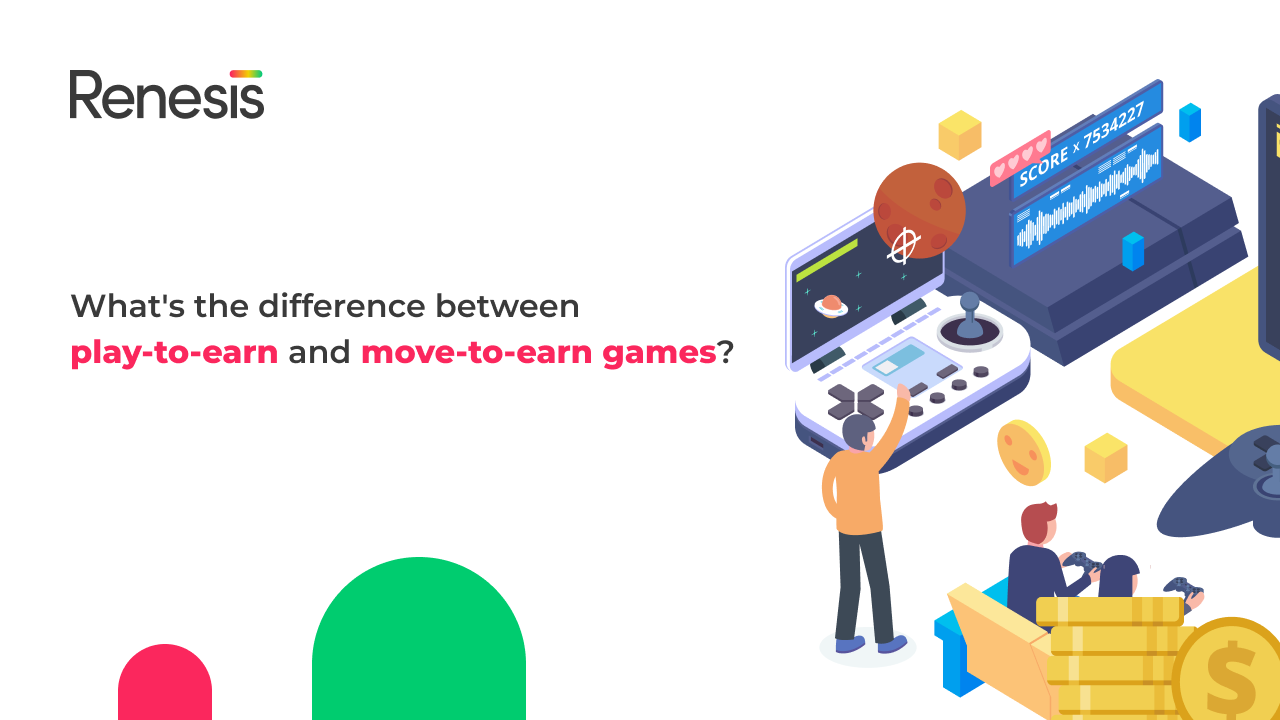What’s the difference between play-to-earn and move-to-earn games?
Games have come a long way since their humble beginnings. Those of us who played Super Mario on a 16-bit console understand how this once-simple industry has evolved into an emotionally-charged, engaging virtual reality industry.
Globally, gaming is gaining traction. DappRadar and Blockchain Game Alliance report from Q1 2022 indicates that blockchain gaming alone has grown more than 2000% over the past year.
Over the past few years, blockchain technology has become increasingly popular due to the need for a new system that can replace the problems existing in the traditional paper money system.
Blockchain isn’t only about money; it has a wide range of applications, with gaming being one of the most crucial. Why? Because blockchain technology will revolutionize how games are created, managed, and played in the future.
In this article, we’ve highlighted two important types of blockchain games. Let’s have a look!
Play-to-earn crypto games
Games where players can earn digital cash or non-fungible tokens reward them with digital cash. Blockchain-backed games also referred to as P2E games, have gone mainstream in recent years, becoming an integral part of nearly every metaverse, each with its own cryptocurrency for payment.
Depending on the game, players are rewarded differently for their in-game activities. As a reward, players can receive cryptocurrency, non-fungible tokens (NFTs), or a value increase for their existing NFTs.
What are the examples of play to earn?
Crypto games such as Axie Infinity, which is based on Ethereum, are well known. It combines video gaming and blockchain gameplay elements. There were days when the NFT marketplace grew rapidly when the economy was thriving. It was a time when hundreds of millions of dollars were being traded and thousands of dollars were being bought and sold for Axies, the magical creatures.
The Sandbox is another game in the P2E industry. By playing this game, users can get a glimpse of what the Metaverse might look like in the future. It is possible for users to play, create, build, and own the future. In addition to enjoying an immersive experience, users can monetize their in-game assets by creating, investing, and earning them.
Move-to-earn games
Move-to-earn boomed during the height of the COVID-19 pandemic. Most people were at home, sitting and staring at screens. Considering how important it is for your health to move frequently, M2E became really popular. This is a new way to reward users for getting up and moving while using technology.
By combining GameFi and Fitness Apps, Move-to-Earn (aka “FitFi”) incentivizes a healthier, more active lifestyle with token rewards. In move-to-earn, you can move, play games, and earn crypto.
Successful move to earn Projects
Launched in December 2021, STEPN enables users to connect their running habits to the blockchain through the use of NFT sneakers. Participants must use geolocation to track their outdoor running and purchase sneakers that match their average speed and fitness level. In order to earn crypto rewards, the player must maintain a consistent pace within the optimal speed range displayed onscreen. Furthermore, the network offers a leaderboard to promote friendly competition and provide additional incentives.
While STEPN is one of the newest FitFi projects, its parabolic growth in the crypto space has made it extremely popular. From its launch to its all-time high on April 28, STEPN’s token price increased nearly 2,500%. As a result, the project now has a market capitalization of more than $2 billion, making it one of the world’s largest cryptocurrencies. Over the course of its lifetime, STEPN has attracted over 368,639 users.
Sweatcoin is similar to the first project. In order to earn coins, users run, walk, and most importantly: sweat. The platform’s native currency, SWEAT, rewards you for taking 1000 steps per day.
With their slogan, “It pays to walk,” they want to decrease the billions of dollars of cost in healthcare by making people healthier.
A final example of M2E projects is MetaGym. It’s easy to join MetaGym, and you can earn money while exercising through an app or even a smartwatch application. The MetaGym Coin (MGCN) provides users with access to the platform’s GameFi, FitFi, and SleepFi features while they sweat it out in order to earn MetaGym Coins (MGCN).
P2E vs M2E Games
Move-to-Earn is an offshoot of the Play-to-Earn model that combines GameFi with SocialFi. Play-to-Earn games reward players with tokens after they win battles, progress through levels, and explore the world. In contrast, Move-to-Earn apps reward players based on their physical activity by using sensors in their mobile devices. By using digital assets, Move-to-Earn gamifies fitness to encourage healthier behavior. Using personal fitness trackers and workplace wellness programs, it hopes to gain traction. Move-to-Earn can reduce medical and insurance costs as well as sick leave by encouraging a healthier lifestyle.
It’s amazing that one can now generate income from physical activities or by winning battles every day. Curious about how to build an application on the blockchain? Contact our Renesis development team today!










